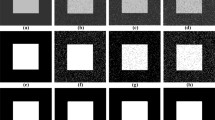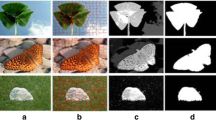Abstract
Gaussian mixture model (GMM) is a flexible tool for image segmentation and image classification. However, one main limitation of GMM is that it does not consider spatial information. Some authors introduced global spatial information from neighbor pixels into GMM without taking the image content into account. The technique of saliency map, which is based on the human visual system, enhances the image regions with high perceptive information. In this paper, we propose a new model, which incorporates the image content-based spatial information extracted from saliency map into the conventional GMM. The proposed method has several advantages: It is easy to implement into the expectation–maximization algorithm for parameters estimation, and therefore, there is only little impact in computational cost. Experimental results performed on the public Berkeley database show that the proposed method outperforms the state-of-the-art methods in terms of accuracy and computational time.








Similar content being viewed by others
References
Sonka M, Hlavac V, Boyle R (2014) Image processing, analysis, and machine vision. Cengage Learning, Boston
McLachlan G, Peel D (2004) Finite mixture models. Wiley, New York
Bishop CM (2006) Pattern recognition and machine Learning 128
Bouguila N (2011) Count data modeling and classification using finite mixtures of distributions. IEEE Trans Neural Netw 22(2):186–198
Yuksel SE, Wilson JN, Gader PD (2012) Twenty years of mixture of experts. IEEE Trans Neural Netw Learn Syst 23(8):1177–1193
Allili MS, Bouguila N, Ziou D (2007) A robust video foreground segmentation by using generalized gaussian mixture modeling. In: Fourth Canadian conference on computer and robot vision, 2007. CRV’07. IEEE, pp 503–509
Allili MS, Bouguila N, Ziou D (2007) Finite generalized Gaussian mixture modeling and applications to image and video foreground segmentation. In: Fourth Canadian conference on computer and robot vision, 2007. CRV’07. IEEE, pp 183–190
Bouwmans T, El Baf F, Vachon B (2008) Background modeling using mixture of gaussians for foreground detection-a survey. Recent Patents Comput Sci 1(3):219–237
El Baf F, Bouwmans T, Vachon B (2008) Type-2 fuzzy mixture of Gaussians model: application to background modeling. In: International symposium on visual computing. Springer, pp 772–781
Shah M, Deng J, Woodford B (2012) Illumination invariant background model using mixture of Gaussians and SURF features. In: Asian Conference on Computer Vision. Springer, pp 308–314
Dempster AP, Laird NM, Rubin DB (1977) Maximum likelihood from incomplete data via the EM algorithm. J R Stat Soc Ser B (Methodolog) 39:1–38
Bilmes JA (1998) A gentle tutorial of the EM algorithm and its application to parameter estimation for Gaussian mixture and hidden Markov models. Int Comput Sci Inst 4(510):126
Denœux T (2011) Maximum likelihood estimation from fuzzy data using the EM algorithm. Fuzzy Sets Syst 183(1):72–91
McLachlan G, Krishnan T (2007) The EM algorithm and extensions, vol 382. Wiley, New York
Figueiredo MAT, Jain AK (2002) Unsupervised learning of finite mixture models. IEEE Trans Pattern Anal Mach Intell 24(3):381–396
Blekas K, Likas A, Galatsanos NP, Lagaris IE (2005) A spatially constrained mixture model for image segmentation. IEEE Trans Neural Netw 16(2):494–498
Nguyen TM, Wu QJ (2012) Gaussian-mixture-model-based spatial neighborhood relationships for pixel labeling problem. IEEE Trans Syst Man Cybern Part B (Cybernetics) 42(1):193–202
Chatzis SP, Varvarigou TA (2008) A fuzzy clustering approach toward hidden Markov random field models for enhanced spatially constrained image segmentation. IEEE Trans Fuzzy Syst 16(5):1351–1361
Diplaros A, Vlassis N, Gevers T (2007) A spatially constrained generative model and an EM algorithm for image segmentation. IEEE Trans Neural Netw 18(3):798–808
Sanjay-Gopal S, Hebert TJ (1998) Bayesian pixel classification using spatially variant finite mixtures and the generalized EM algorithm. IEEE Trans Image Process 7(7):1014–1028
Tang H, Dillenseger J-L, Bao XD, Luo LM (2009) A vectorial image soft segmentation method based on neighborhood weighted Gaussian mixture model. Comput Med Imaging Graph 33(8):644–650
Zhang H, Wu QJ, Nguyen TM (2013) Image segmentation by a robust modified gaussian mixture model. In: 2013 IEEE international conference on acoustics, speech and signal processing. IEEE, pp 1478–1482
Zhang H, Wu QJ, Nguyen TM (2013) Incorporating mean template into finite mixture model for image segmentation. IEEE Trans Neural Netw Learn Syst 24(2):328–335
Treisman AM, Gelade G (1980) A feature-integration theory of attention. Cogn Psychol 12(1):97–136
Cheng M-M, Mitra NJ, Huang X, Torr PH, Hu S-M (2015) Global contrast based salient region detection. IEEE Trans Pattern Anal Mach Intell 37(3):569–582
Rensink RA, O’Regan JK, Clark JJ (1997) To see or not to see: the need for attention to perceive changes in scenes. Psychol Sci 8(5):368–373
Rensink RA, Enns JT (1995) Preemption effects in visual search: evidence for low-level grouping. Psychol Rev 102(1):101
Rensink RA (2000) Seeing, sensing, and scrutinizing. Vision Res 40(10):1469–1487
Itti L, Koch C, Niebur E (1998) A model of saliency-based visual attention for rapid scene analysis. IEEE Trans Pattern Anal Mach Intell 20(11):1254–1259
Borji A, Itti L (2013) State-of-the-art in visual attention modeling. IEEE Trans Pattern Anal Mach Intell 35(1):185–207
Walther D, Itti L, Riesenhuber M, Poggio T, Koch C (2002) Attentional selection for object recognition—a gentle way. In: International workshop on biologically motivated computer vision. Springer, pp 472–479
Hou X, Zhang L (2007) Saliency detection: a spectral residual approach. In: 2007 IEEE conference on computer vision and pattern recognition. IEEE, pp 1–8
Ruderman DL (1994) The statistics of natural images. Netw Comput Neural Syst 5(4):517–548
Srivastava A, Lee AB, Simoncelli EP, Zhu S-C (2003) On advances in statistical modeling of natural images. J Math Imag Vis 18(1):17–33
Krinidis S, Chatzis V (2010) A robust fuzzy local information C-means clustering algorithm. IEEE Trans Image Process 19(5):1328–1337
Martin D, Fowlkes C, Tal D, Malik J (2001) A database of human segmented natural images and its application to evaluating segmentation algorithms and measuring ecological statistics. In: Proceedings of eighth IEEE international conference on computer vision, 2001. ICCV 2001. IEEE, pp 416–423
Unnikrishnan R, Pantofaru C, Hebert M (2007) Toward objective evaluation of image segmentation algorithms. IEEE Trans Pattern Anal Mach Intell 29(6):929–944
Acknowledgement
This work was supported by the National Natural Science Foundation of China under Grants 61271312, 61201344, 61401085, 31571001 and 81530060; by Natural Science Foundation of Jiangsu Province under Grants BK2012329, BK2012743, BK20150647, DZXX-031, BY2014127-11; by the ‘333’ Project under Grant BRA2015288; and by the Qing Lan Project.
Author information
Authors and Affiliations
Corresponding author
Rights and permissions
About this article
Cite this article
Bi, H., Tang, H., Yang, G. et al. Accurate image segmentation using Gaussian mixture model with saliency map. Pattern Anal Applic 21, 869–878 (2018). https://doi.org/10.1007/s10044-017-0672-1
Received:
Accepted:
Published:
Issue Date:
DOI: https://doi.org/10.1007/s10044-017-0672-1




